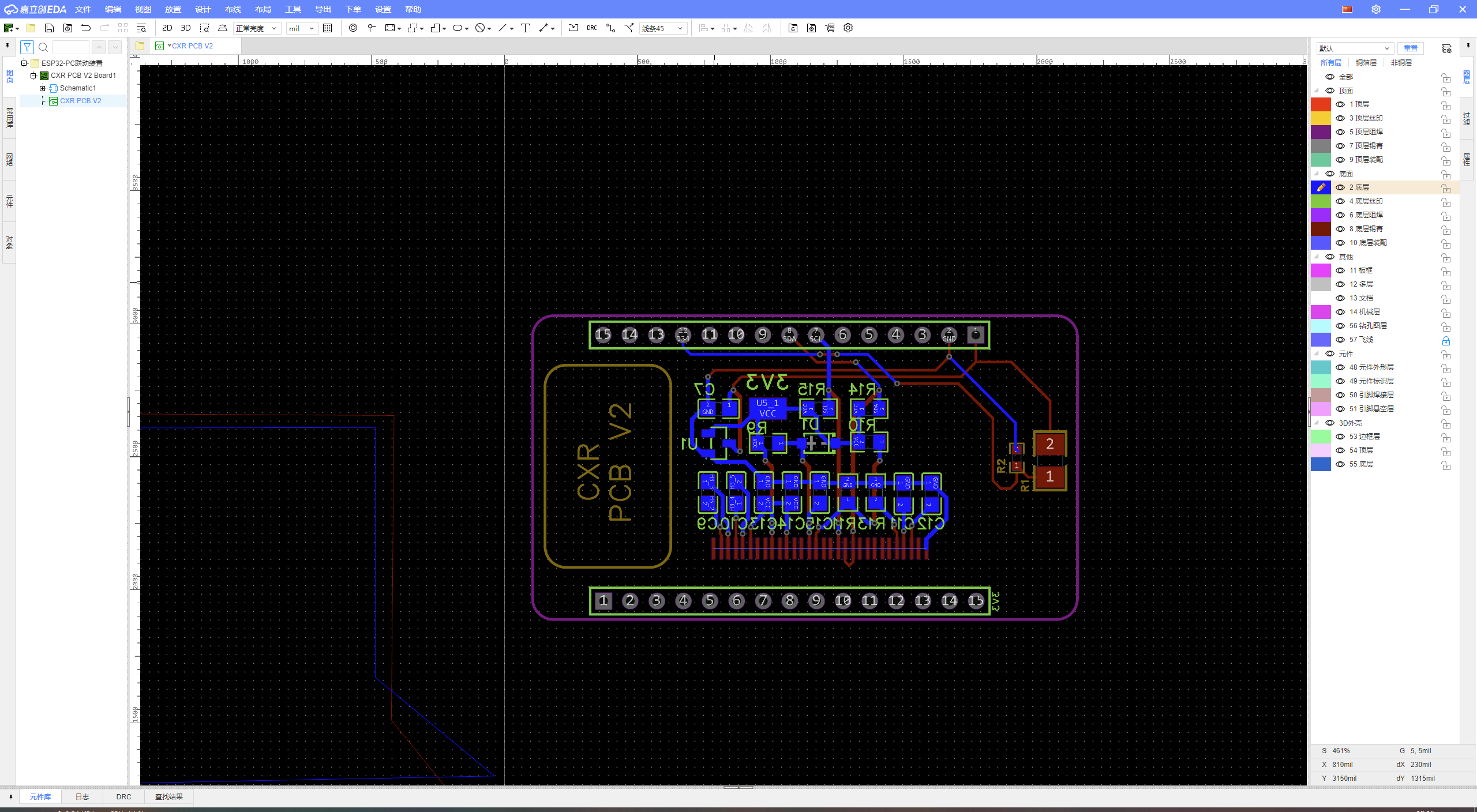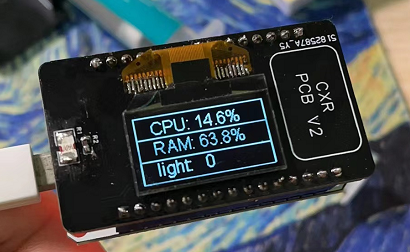从零开始设计一个ESP-32 for PC联动装置
硬件准备:ESP32-WROOM-32开发板
SSD1306显示器(不带驱动板)
嘉立创打板,工程文件地址:lanzouw.com/i9XhY0e6qhuj 密码:5ykd
下单板子并且根据工程文件下单元件。
焊接。

拿出ESP32-WROOM-32开发板,用Arduino.exe烧录程序。
#include "SSD1306.h" #include <Arduino.h> #include "BluetoothSerial.h" #if !defined(CONFIG_BT_ENABLED) || !defined(CONFIG_BLUEDROID_ENABLED) #error Bluetooth is not enabled! Please run `make menuconfig` to and enable it #endif SSD1306 display(0x3c, 25, 26); String str=""; RTC_DATA_ATTR int bootCount = 0; const int potpin = 34; int potValue = 0; BluetoothSerial SerialBT; void setup() { pinMode(LED_BUILTIN, OUTPUT); SerialBT.begin("ESP32test"); //Bluetooth device name SerialBT.printf("ESP32 is restart now! It's the %d time\r\n", ++bootCount); display.init(); display.setFont(ArialMT_Plain_16); Serial.begin(115200); //set up serial library baud rate to 9600 } void loop() { digitalWrite(LED_BUILTIN, HIGH); str = ""; while (SerialBT.available() > 0) { display.clear(); str += char(SerialBT.read()); // read是剪切,而不是复制 display.drawString(15, 42 , "light: " + String(potValue)); delay(10); // 延时2 } potValue = analogRead(potpin); SerialBT.println(potValue); display.drawString(15, 3, str); display.drawRect(0, 0, 128, 64); display.drawHorizontalLine(0, 21, 128); display.drawHorizontalLine(0, 42, 128); display.display(); digitalWrite(LED_BUILTIN, LOW); delay(100); }
烧录好之后打开PC蓝牙,连接“ESP32test”。
PC上运行以下python程序:
import serial import time import psutil def get_cpu(): psutil.cpu_percent(None) # 第一次返回的结果是0 time.sleep(0.5) return psutil.cpu_percent(None) def get_ram(): return psutil.virtual_memory().percent def poweroffSchedule(text): ser = serial.Serial('com5', 115200, parity='E', stopbits=1, bytesize=8, timeout=0.5) ser.write(text.encode("gbk")) print('光照强度:' + ser.readline().decode('utf-8')) # ser.close() if __name__ == "__main__": # for i in li: while True: poweroffSchedule('CPU:' + ' ' + str(get_cpu()) + '%\r\n' + 'RAM:' + ' ' + str(get_ram()) + '%') time.sleep(1)
成品如下:

#include <Arduino.h> #include <U8g2lib.h> #include "BluetoothSerial.h" #if !defined(CONFIG_BT_ENABLED) || !defined(CONFIG_BLUEDROID_ENABLED) #error Bluetooth is not enabled! Please run `make menuconfig` to and enable it #endif String str=""; RTC_DATA_ATTR int bootCount = 0; const int potpin = 34; int potValue = 0; BluetoothSerial SerialBT; U8G2_SSD1306_128X64_NONAME_F_SW_I2C u8g2(U8G2_R0, /* clock=*/ 26, /* data=*/ 25, /* reset=*/ U8X8_PIN_NONE); // ESP32 Thing, pure SW emulated I2C int intArray [3]; void setup(void) { u8g2.begin(); u8g2.enableUTF8Print(); // enable UTF8 support for the Arduino print() function pinMode(LED_BUILTIN, OUTPUT); SerialBT.begin("ESP32test"); //Bluetooth device name SerialBT.printf("ESP32 is restart now! It's the %d time\r\n", ++bootCount); Serial.begin(115200); //set up serial library baud rate to 115200 } void loop(void) { digitalWrite(LED_BUILTIN, HIGH); str = ""; u8g2.setFont(u8g2_font_unifont_t_chinese2); // use chinese2 for all the glyphs of "你好世界" u8g2.setFontDirection(0); while (SerialBT.available() > 0) { u8g2.clearBuffer(); str += char(SerialBT.read()); // read是剪切,而不是复制 u8g2.setCursor(0, 15); u8g2.print("light: " + String(potValue)); //display.drawString(15, 42 , "light: " + String(potValue)); delay(10); // 延时2 } potValue = analogRead(potpin); SerialBT.println(potValue); // intArray [2] =3; // intArray [1] =2; // intArray [0] =1; u8g2.setCursor(0, 40); u8g2.print(intArray [1]); // Chinese "Hello World" u8g2.sendBuffer(); digitalWrite(LED_BUILTIN, LOW); delay(100); //\ // display.drawString(15, 3, str); // display.drawRect(0, 0, 128, 64); // display.drawHorizontalLine(0, 21, 128); // display.drawHorizontalLine(0, 42, 128); // display.display(); // delay(100); }
本文作者:c/
本文链接:https://www.cnblogs.com/ff888/p/16807426.html
版权声明:本作品采用知识共享署名-非商业性使用-禁止演绎 2.5 中国大陆许可协议进行许可。




【推荐】国内首个AI IDE,深度理解中文开发场景,立即下载体验Trae
【推荐】编程新体验,更懂你的AI,立即体验豆包MarsCode编程助手
【推荐】抖音旗下AI助手豆包,你的智能百科全书,全免费不限次数
【推荐】轻量又高性能的 SSH 工具 IShell:AI 加持,快人一步